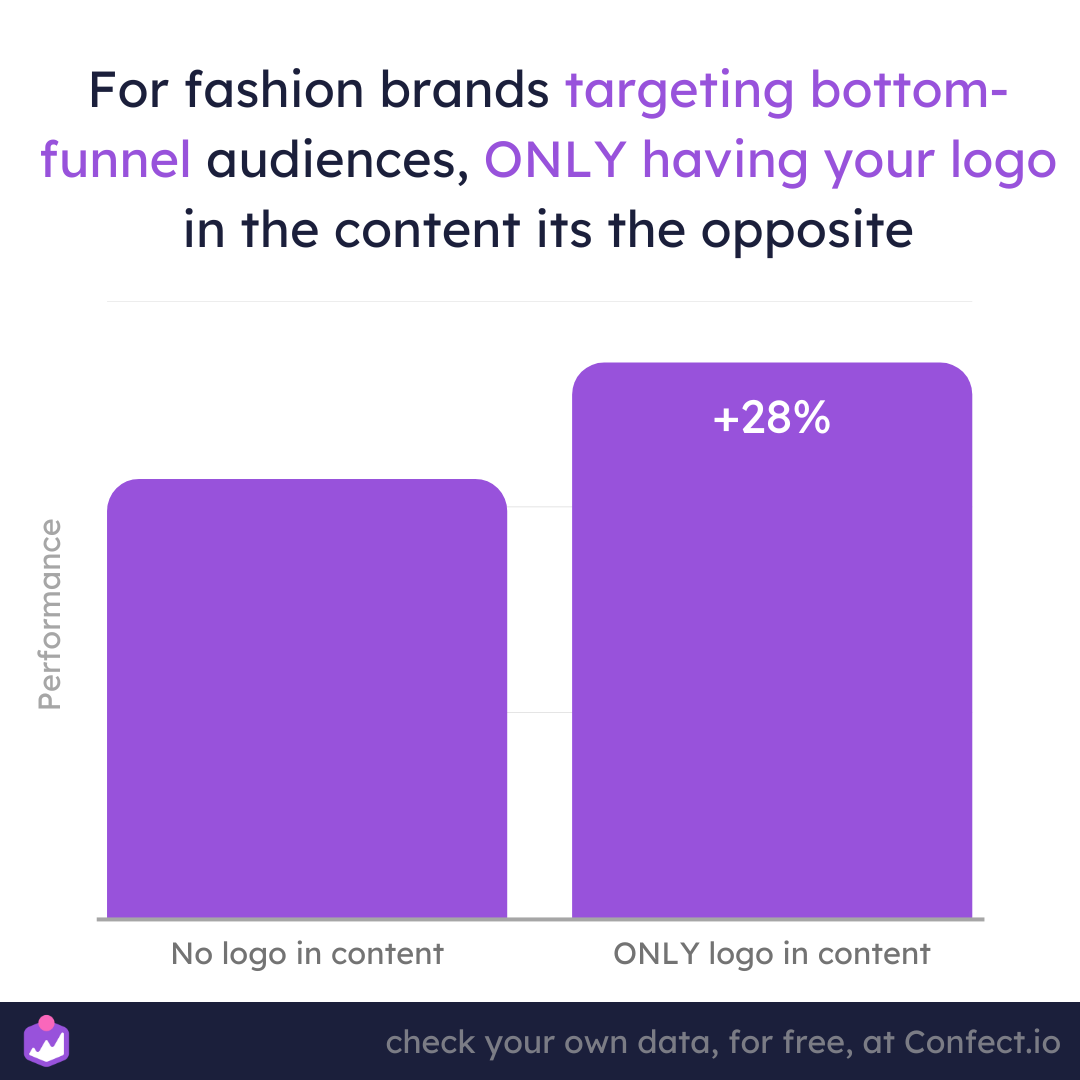How do logos impact performance for fashion ads
August 2, 2022
Brand is everything, especially in the fashion industry.
One common way of building brand association is by showing your logo in your ads.
But just because you show your logo in your fashion ads, doesn’t mean they will improve performance.
Let’s dive in and take a closer look.
Logos in fashion ads perform worse then without
While showing your logo may build some long-term brand effects like brand association, the performance of your ad suffers.
We found that in general, having your logs in your content decreases performance by 11%.
Having no logo performs better (remember we’re talking about conversions/sales when we mention performance).
Instead of showing your logo, we suggest using other assets from your brand like colors, fonts, images, themes, etc.
In general, showing your logo in your fashion ads causes a decrease in performance.
.png)
If having a logo in your ads decreases performance, should you just never show your logo?
Fashion ads talking about shipping actually performs better if logo is used
Ads that talk about shipping(returns are included here) are considered information that’s already relevant to customers at the bottom of the funnel.
The brand association, aka the logo, is there to reassure customers that this is the right place to buy!
On the other hand, ads talking about “new” like new products, new collections, etc. showing a logo decreases performance by 41%.
For “new” ads you might want to consider using logos on more branded campaigns where conversions aren’t the goal.
If sales are your goal and your ad message type is shipping, consider using logos in your content for better performance.
.png)
All these types of ads usually have something else in the content like products, models, graphics, etc.
But what about ads showing just the logo?
Logo with no other information in fashion ads works terrible
It’s common for fashion brands to launch ads showing just their logo.
They believe their brand is everything, and so they want to show it off.
This is not an issue when building brand awareness, brand association, etc.
But when your goal is conversions, specifically sales, performance seems to drop.
We found that in fashion ads where only the logo is shown performance drops by 31%!
If your goal isn’t reach or awareness, your fashion ads’ performance will drop if you only show the logo.
.png)
Keep in mind that this performance drop is mainly from your top funnel audiences.
If that’s the case, what does it look like for your bottom-funnel audiences?
Logo only works good for fashion brands bottom of the funnel
Interestingly, ads that just have your logo work very well for bottom-funnel audiences.
The bottom-of-the-funnel audiences most likely recognize and had interactions with your brand before.
Top funnel audiences might not be interested in your brand or have had very few interactions.
It might be worth considering segmenting your ads, meaning, targeting your top funnel with ads with less or no logos, and targeting your bottom-funnel audiences with logos and even logo ONLY ads.
Especially for fashion brands, showing ONLY your logo in your content can boost performance.

Run your own tests on your funnel audiences
In general, showing your logo not only doesn’t do much to improve performance but also might decrease performance.
Unless your ad messaging is talking about shipping, which performs better with a logo in the content, showing your logo could decrease your performance down to -41%!
Test out your ads with and without logos on different parts of your funnel and see what kind of results you come up with.
Remember, every business is different, so results may vary!
More to read
This article focuses on logos in fashion content. Keep learning and optimizing with the following insights:
- Better performance by fixing ad bodies for fashion ads
- Content learnings from top fashion brands
- How effective are models in fashion ads
- Shipping and Free returns for fashion ads
- Create better SALES ads for fashion
- Tips how to use text for fashion ads
- How can fashion brands sell New products more effectively
Dataset
The dataset from this article is based on 967m+ impressions and 9500+ pieces of individual content on Meta (Facebook) platforms from Fashion brands ONLY. It takes into account data from only brands within fashion industry in all countries, with the campaign objectives of conversions only. The period is from 01.09.2021 - 16.09.2022.
Numbers are looking at correlation only, not causation. Remember to check your own data: numbers for different brands, industries, and contexts will vary. If you were intrigued about a specific insight, you can go in-depth into the various dimensions and how data can be segmented in Confect, here.
